QCF: Cyber Shadow
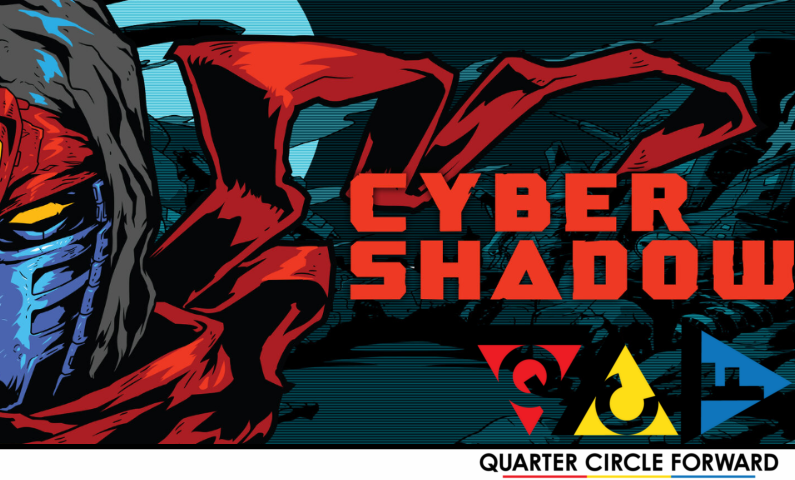
 f there’s only one video game platform from the past that has to lead an everlasting brain trust spread throughout all walks of life, it’s the Nintendo Entertainment System. There are a bevy of other 8-bit machines that have their fans sure, but the NES has defined what people consider the 8-bit generation to be, establishing a style that still permeates a majority of the throwback indie titles that’s seen in the market today.
f there’s only one video game platform from the past that has to lead an everlasting brain trust spread throughout all walks of life, it’s the Nintendo Entertainment System. There are a bevy of other 8-bit machines that have their fans sure, but the NES has defined what people consider the 8-bit generation to be, establishing a style that still permeates a majority of the throwback indie titles that’s seen in the market today.
Drawing inspiration from the system’s aesthetics is one thing, but capturing the gameplay of that era is an entirely different beast, especially when it comes to channeling the essence of the challenge it’s famous for in an age of Save States and unlimited continues. Enter Mechanical Head Studio’s Cyber Shadow, a new title published by Yacht Club that chases the old ghosts of NES classics like Ninja Gaiden, Power Blade, Shatterhand, Shadow of the Ninja, and so much more—complete with a modern touch that aims to balance the scale of difficulty and fairness on the tightest of ropes.
There’s a lot to enjoy here for those who cut their teeth on the action genre during the days of the rectangular controller, but on that same token, arguably much of the beauty behind that generation is the “less is more” philosophy behind those games—something that Cyber Shadow is remiss to forget in its occasionally clumsy ambition.
In a setting where actions speak louder than words, the Sci-Fi Ninja adventure from Mechanical Head Studios makes it a point not to mince words, showcasing a bright yet dystopian world that’s still reeling from a tug-of-war between technology and tradition. Tecmo’s Ninja Gaiden not only revolutionized the level of intensity a Character-Action game could deliver on the Famicom and NES, but it also transformed narrative story-telling for the time, so naturally, it comes as no surprise that the beats of Cyber Shadow expand this concept, only with a much more cinematic approach.
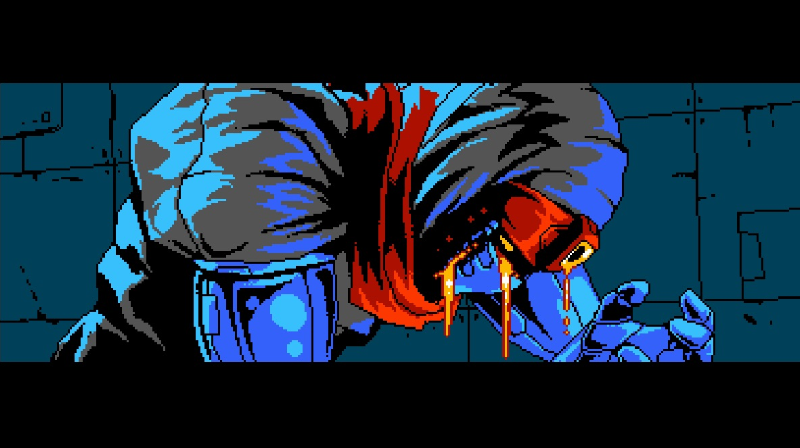
As the view of Mekacity pans backward, players are treated to the violent aftermath of a citywide explosion that decimated the metropolis into rubble. We’re then introduced to a mute and weakened warrior known only as Shadow, who has been in enemy captivity for a majority of the disastrous events that had unfolded, taking on a “Historical Present” approach for the plot direction for the duration of the adventure. The narrative direction is novel in that it not only introduces in-depth developments through journal logs and environmental transcripts that dive into dense world-building without any slowdown to the gameplay, but it 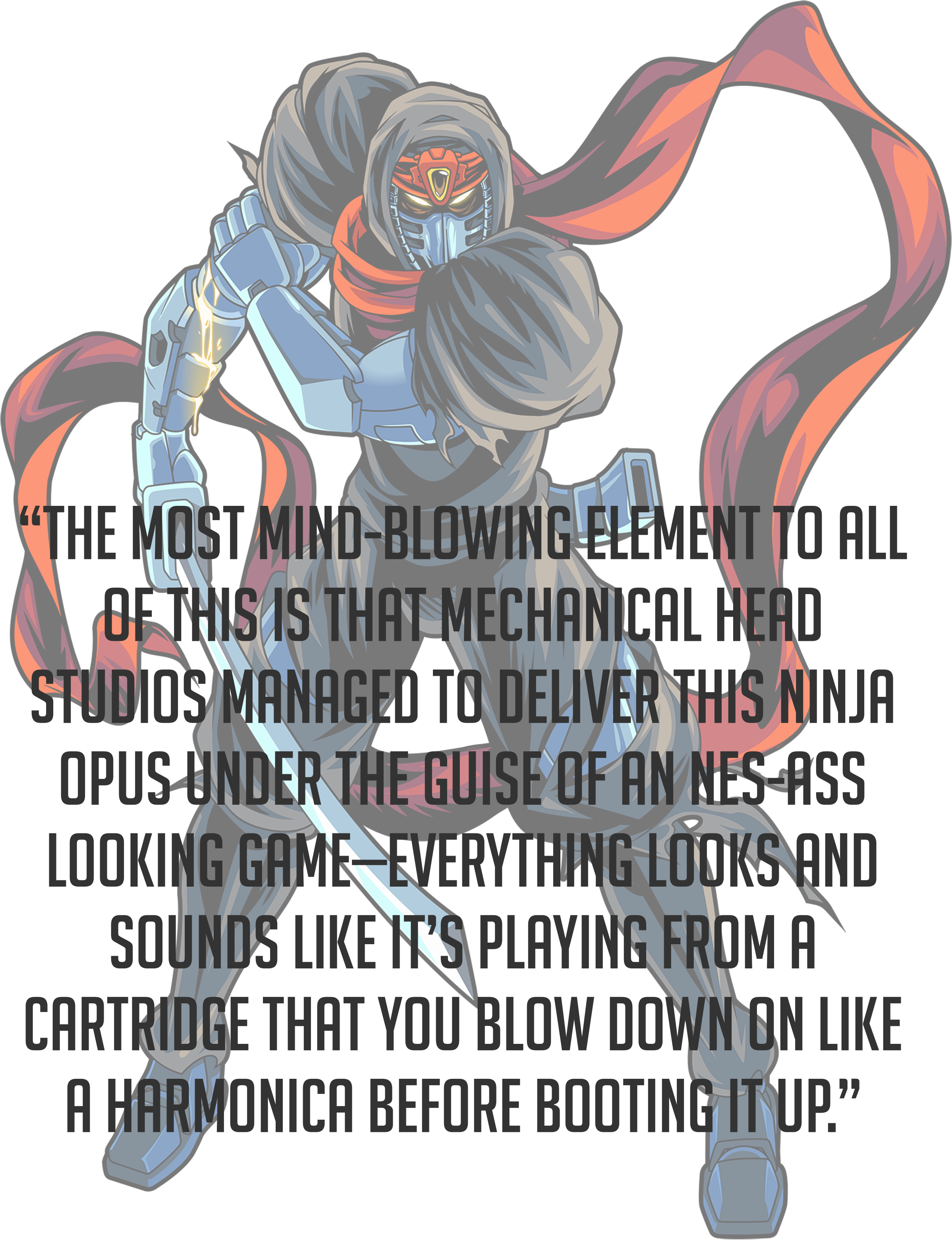 also gates the latent abilities of Shadow’s move-set, phonetically pacing the gameplay to the story in a way not many 8-bit inspired worlds have before it.
also gates the latent abilities of Shadow’s move-set, phonetically pacing the gameplay to the story in a way not many 8-bit inspired worlds have before it.
The first couple of stages feature an amnesiac warrior that’s still getting their bearings to the situation, and in that gangling state, the level design is built around the limited skillset of jump and attack in the beginning stages before advancing to something more complex. In a medium that’s plagued by Ludonarrative dissonance more than other of its kind, Cyber Shadow delivers this incredible sense of growth from all of its moving parts.
The most mind-blowing element to all of this is that Mechanical Head Studios managed to deliver this Ninja Opus under the guise of an NES-ass looking game—everything looks and sounds like it’s playing from a cartridge that you blow down on like a harmonica before booting it up.
The appeal of the art direction is, while likely impossible, the deliberate design of the spritework and color pallets involved with the graphics of Cyber Shadow could arguably pass for a late-generation title you would find on the iconic Nintendo platform. Even the use of more advanced techniques like parallax scrolling, transparencies, and expanded sound channels are woven into the makeup of Cyber Shadow are used sparingly throughout the title in the same rhythm of the game’s other pacing decisions. The soundtrack, man y’all—if there’s anything to take away from this review of Cyber Shadow, it’s just how amazing this game sounds. Composed by Enrique Martin AKA Pentadrangle, with Production support from the legendary chiptune artist, Jake Kaufman, the synthesized wales, and effervescent beats of game’s tracks redefine what 8-bit music can be—it’s really that good. The tracks that stick out to me the most are “Mekacity Ruins” that plays for Chapter 3, and “Research Lab for Chapter 5 because the compositional design of layered synth notes over the scratchy-but-accurate percussion is reminiscent of the expanded sound capabilities of the Famicom and notable titles that used this expanded tech like Lagrange Point and Gimmick.
While Cyber Shadow starts really strong on all fronts, however, it, unfortunately, gets a little ahead of itself and inadvertently splinters the careful balance it crafted earlier in the quest.
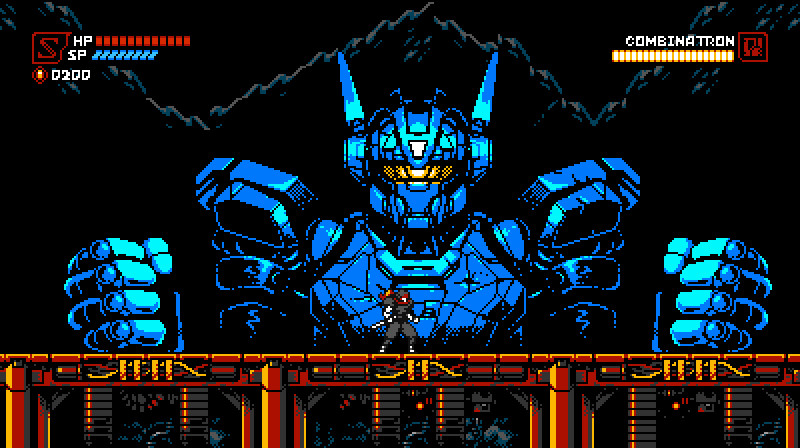
Completing a chapter will gradually develop Shadow’s arsenal of abilities, steadily ranging from Shuriken projectiles to a downward sword strike akin to Adventure of Link, to the eventual wall kick and dash strikes that’re available in the latter half of the game. Some of these abilities will use a “Spirit” gauge that Shadow uses to fuel these actions much like the trademark weapon energy capsules found in the Mega Man series. How and you choose to deploy these special abilities will influence your chances of success in some of the more grueling obstacles of Cyber Shadow’s late game. Speaking of the late game, one of the more pivotal mechanics to the game’s side-scrolling combat is the parry mechanic, where players will be allowed to reflect any projectile attack shot at them by tapping forward right before impact. The maneuver, while artful in its execution, isn’t as responsive as it can be, especially when you factor the command for the dash ability, which asks players to double-tap the directional input they wish to rush forward.
I can’t tell you how many times these two separate actions and their similar input commands conflicted with one another, often driving me right into the line of fire instead of ricocheting it back at the enemy as I had originally intended. The dash ability itself is needlessly tricky in hindsight, as it too demands precision to execute properly, a factor that’s even more challenging in areas where there isn’t a lot of runway to pull of the sprint, or the rapid speed of an auto-scroll section can pressure the entry into faltering. I understand that working around a limited-button interface is part of the authentic 8-bit experience, but that argument is flimsy in this case. When you’re already in the murky territory of running your 8-bit visuals at high definition with a 16:9 aspect ratio instead of 4:3, you can stretch that illusion of the “retro” spectacle a little further by mapping the dash to a button of its own on an 8-button controller. The complexity and nuance of these inputs under the often hectic side-scrolling conditions just aren’t responsive enough to merit the convoluted circumstances of their application—that’s the sort of “challenge” that can stay in the Eighties.
Fortunately, the checkpoints in the strewn about every level are, for the most part, forgiving in their placement with the exception of a select few at the very tail-end of the campaign. The checkpoints also come with some quality of life utilities that players are free to take advantage of any time they encounter these blessed spots in the level. At the cost of in-game currency that you can find through the course of the stages and defeat of random enemies, players will have the chance to decide between whether or not they would like to pay to refill their health meter, spirit meter, or both if the ninja cash is willing. In addition to these recharges, most checkpoints will also feature one of eight sub-weapon tools that Shadow can use up until he is hit three times before the tool permanently breaks.
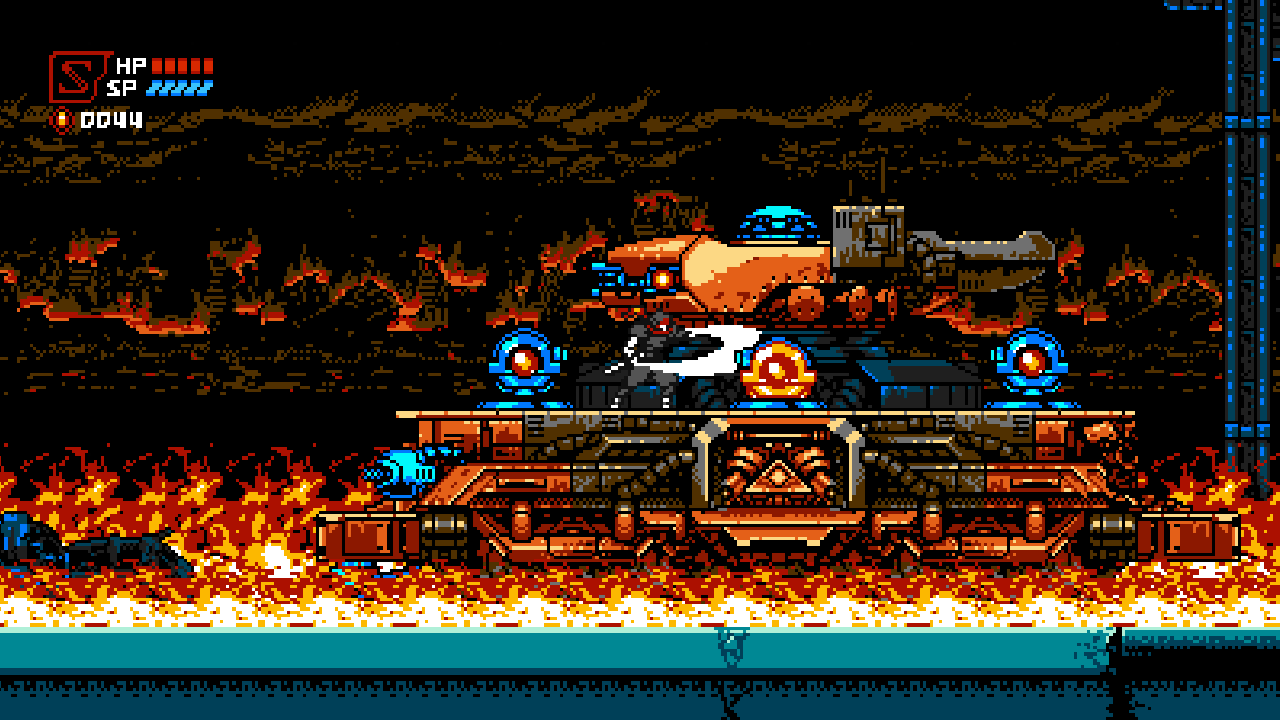
These extra tools are novel in that specific tool that’s available at that moment has just the right specialty to counter most of the hazards that lie ahead of that given Checkpoint. The Swag Blade for example is a swinging blade that independently swings around Shadow at all times, damaging anything it makes contact with, controlled only by Yoyo physics that anchor from the ninja’s movement. When you’re first introduced to the weapon, the course of the level that follows is littered with enemies that are position in nearly all directions of the screen, and a large majority of them out of Shadow’s normal attack range. The key to conquering the area is to effectively move in a way that will not only evade enemy contact, but also guide the Swag Blade to collide against any hapless foe that’s caught in the direction of its pull. Using it successfully enough will give you the chance to deploy it against the boss of that area, the Biohunter, an airborne foe that rarely gives you a window of opportunity to strike with your normal reach, but is a foe that’s all the more vulnerable to the wild reach of the Swag Blade.
These optional weapons are not only a great way to level the playing field for some of the game’s trickier sections, but they’re completely optional for the sadists who want to push themselves.
If the game were have existed in a vacuum, I’d say that Cyber Shadow is the best game of its kind, but with other titles that have been able to deliver the same type of “old-school” challenge it boasts more elegantly, it would be more accurate to say that Cyber Shadow is among some of the best retro-inspired affairs instead. Rest assured though, the only real crime of Cyber Shadow are the moments where it tries to do too much with too little and the lines the developers have chosen to draw in some of those key areas. The debut release from Mechanical Head Studios is an otherwise stellar experience that magically captures that feeling we all had at some point in our youth when we slapped a new cart into the toaster-shaped machine and feverishly flipped the television to channel 3 to get the game started.





 GeorgieBoysAXE
GeorgieBoysAXE




